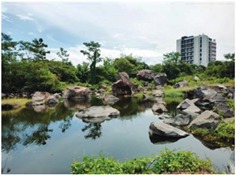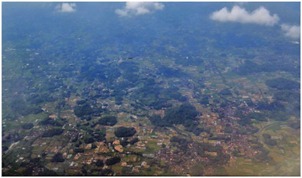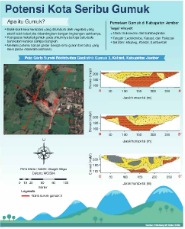Collaboration Between ITB and Jember University Researchers to Explore the Potential of Nature in the City of A Thousand Dunes
By Adi Permana
Editor Adi Permana

BANDUNG, itb.ac.id—Indonesia is geographically located within the ring of fire. As a consequence of this condition, Indonesia has a lot of volcanoes that potentially cause eruptions and earthquakes. However, if this gift is properly managed, the local community will benefit substantially.
One of them is the 'City of a Thousand Dunes,' a nickname for a neighborhood in Jember Regency and its environs. Therefore, a research team was formed to investigate the Spatio-Temporal Analysis of Volcanic Dunes Distribution to Identify the Potential of Sand-Bacu Minerals in the Southern Part of East Java.
The research team included members of the Earth Resources Exploration Research Group FTTM ITB, the Petrology, Volcanologist, and Geochemistry Research Group FITB ITB, the Mining Engineering Study Program FT Jember University, and FTTM ITB students who are members of the ITB 2021 Leading Research Program.
Dunes are small, isolated hills that are overgrown with denser vegetation than the surrounding area. Dunes are sand masses embedded in the ground that is generally rock-shaped (as large as gravel to boulders). The presence of a dune provides excavated materials in the form of sand and stone. Mount Raung (on the east side), which is still active, and Mount Argopuro (on the northwest side) cause dunes to form in the 'City of a Thousand Dunes.'

*Dunes location observed in Jember on April 22, 2018. Source: Mohamad Nur Heriawan.
People in Sukowono, Sumberjambe, Ledokombo, and Kalisat sub-districts typically mine large dunes. They dig with mechanical tools or hammers. These mining products can be utilized as road materials or building foundations. Some former mining sites (ex-dunes) have been revitalized as recreational areas and restaurant locations, particularly in downtown areas like Sumbersari District.

*Former dune that has been converted into a fishing pond in Sumbersari District. Source: Mohamad Nur Heriawan
Mohamad Nur Heriawan, Ph.D., an ITB Mining and Petroleum Engineering Faculty Lecturer, discusses his research in the ITB Engineering Rubric December 21, 2021 edition. He is a lecturer and researcher in the Earth Resources Exploration Research Group.
According to Heriawan, the first field survey took place from March 30 to April 21, 2021, with the support of PT Sedaya Berkah Sentosa (SBS). In Jember Regency, SBS is one of the holders of a mining business permit for rocks. This survey aimed to map the dune's distribution. The distribution area was divided into three sections: Sukowono and Sumberjambe; the central region consisting of Ledokombo, Kalisat, and Pakusari; and the southern region consisting of Mayang, Kalisat, and Sumbersari.
"As part of this survey, rock fragment samples were collected from 13 locations explored at the Mineralogist, Microscopy, and Geochemical Laboratory, FTTM ITB." The sample was then petrographically analyzed to determine the types of pests that comprise the dune. According to the research, the dune was composed of two types of materials: tuffaceous breccia and tuffaceous sand.
According to the Geological Map of the Jember Sheet (1992), the research area was separated into three rock formations: the Bagor Formation, the Gunung Api Raung Formation, and the Tufa Argopuro. In 2000, NASA used SRTM (Shuttle Radar Topography Mission) photos to study the spread of dunes. Images from NASA's ASTER (Advanced Spaceborne Thermal Emission and Reflection Radiometer) were also used to conduct a multitemporal analysis to determine changes in dunes distribution from 2000 to 2020. This analysis can determine the current existence of the dune in Jember Regency by estimating the number of dunes mined and their location.
"The investigation didn't end in April 2021. On August 23-29, 2021, a geophysical survey (geoelectric resistivity) was carried out. According to the survey results, the pattern of distribution of gravel material remains on the surface," explained the French graduate of the Paris School of Mines.
Processing Minerals that are Both Useful and Environmentally Friendly
According to Heriawan, the findings of this study will be used by local governments to enact policy on natural resource use and management. According to the findings, the 'City of a Thousand Dunes' natural potential comprises not only sand, but also iron ore, limestone, manganese, and gold.
It is necessary to research mineral processing procedures so that mining can continue to be environmentally conscious. Improper mineral processing can harm the local community. Other areas that have successfully used ex-mining sites can serve as models. However, in this case, local government oversight and direction are required.
The full article on this research has been published in Media Indonesia's Rekacipta ITB rubric on December 21, 2021, via the link https://research.lppm.itb.ac.id/information/metakan_potensi_alam_kota_seribu_gumuk
Reporter: Michelle Febriyana Chandra (Architecture, 2020)
Translator: Naffisa Adyan Fekranie (Oceanography, 2019)

.jpg)
.jpg)
.jpg)
.jpg)
.jpg)


